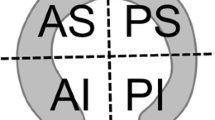Summary
Magnetic Resonance imaging with its excellent soft tissue contrast represents the method of choice for examination of intraarticular and periarticular structures of joints. However, conventional MR-imaging without intraarticular contrast application is not suitable for the diagnosis of labral lesions. MR-arthrography (MRA) of the hip clearly demonstrates labral pathology by distension of the joint space and entrance of the contrast medium into the lesion. Multiplanar 3-D-gradient echo sequences enable visualisation of the most important cranio-ventral portion of the labrum. With the MRA labral lesions can be subdivided into different, clinically relevant stages. Furthermore accompanying lesions (intra- and extraosseous ganglia, stress-bone marrow-edema) can be demonstrated. In our study including operatively verified cases, MRA showed excellent sensitivity (90 %) and accuracy (91 %) in detecting labral lesions. So far no complication occurred with more than 100 MRA's. Therefore this technique represents the method of choice for the radiological evaluation of labral lesions of the hip joint. In this review the technical details and results of our MRA method will be presented.
Zusammenfassung
Die Magnetresonanztomographie (MRT) mit ihrem hohen Weichteilkontrast ist die bildgebende Methode der Wahl zur Darstellung der intraartikulären Strukturen und der umgebenden Weichteile der Gelenke. Zur Diagnostik von Labrumläsionen des Hüftgelenks ist die Nativ-MRT jedoch nicht geeignet. Die MR-Arthrographie (MRA) des Hüftgelenks erlaubt durch die Distension des Gelenkraums und Markierung der Läsion die direkte Darstellung von Labrumläsionen. Multiplanare dreidimensionale (3D-)Sequenzen ermöglichen die Beurteilung in den entscheidenden kranioventralen Abschnitten. Die Labrumläsionen können mit der MRA in verschiedene, klinisch relevante Stadien eingeteilt werden. Zusätzlich ist auch die Darstellung von Begleitläsionen (intra- und extraossäre Ganglien, Streßödeme) möglich. In einer von uns durchgeführten Studie mit operativ verifizierten Fällen zeigte die MRA eine ausgezeichnete Sensitivität (90 %) und Treffsicherheit (91 %). Bei den inzwischen über 100 durchgeführten Arthrographien traten bisher keine Komplikationen auf. Aufgrund dieser Erfahrungen stellt die MRA die Methode der Wahl zur bildgebenden Diagnostik von Labrumläsionen dar. In dieser Übersichtsarbeit stellen wir die Technik und Ergebnisse der von uns verwendeten MRA-Methode vor.
Similar content being viewed by others
Author information
Authors and Affiliations
Rights and permissions
About this article
Cite this article
Urban, M., Hofmann, S., Tschauner, C. et al. MR arthrography in lesions of the labrum acetabulare.. Orthopäde 27, 691–698 (1998). https://doi.org/10.1007/PL00003454
Published:
Issue Date:
DOI: https://doi.org/10.1007/PL00003454




